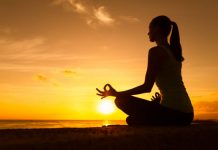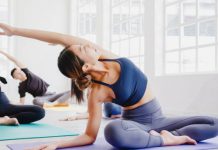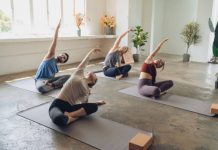Hatha yoga is a slow-paced style of exercise that focuses on breathwork timed with movement. It balances the three gunas and increases muscle strength and endurance. Various forms of Hatha yoga can be found in fitness classes. These classes may be geared towards beginners or experienced practitioners.
Contents
Hatha Yoga is a Slow-Paced Style
Slow-Paced Movement With Multiple Health Benefits
Hatha yoga is a style of yoga that emphasizes slow, steady movement, and offers numerous yoga health benefits. The poses are held for longer periods than Vinyasa yoga and focus on strengthening and stretching the muscles at the same time. Moreover, it emphasizes mindfulness and relaxation.
Stress Reduction, Strength, Flexibility, and Heart Health
A typical Hatha yoga class ends with a short meditation. It has numerous health benefits, including yoga for heart health, and is commonly practised to reduce stress and anxiety. In addition, it improves one’s strength, flexibility, and range of motion.
A Relaxing and Beginner-Friendly Yoga Style
Hatha yoga is more relaxing than other yoga styles. Beginners will find it easier to practice this style, which is slower-paced but also focuses on spirituality and meditation.
Physical Postures, Breathing Techniques, and Meditation
In a typical hatha yoga class, you’ll learn physical postures, including hatha yoga poses, breathing techniques, and meditation. In addition, your yoga instructor will likely introduce you to meditation.
Hatha yoga includes many different styles of physical postures. One of the most popular is Iyengar yoga, which focuses on a slow, gentle pace. It’s a good choice for beginners and people recovering from an injury. It’s also one of the most accessible styles of yoga, promoting yoga for flexibility.
Vinyasa Yoga: Combining Speed and Meditation
Vinyasa yoga, on the other hand, is fast. It combines the slow, meditative effect of Hatha yoga with the physical benefits of flow yoga. Both styles emphasize alignment, precision, and controlled breathing.
This style can be challenging for beginners, but it can be beneficial to those who are more athletic.
Props in Hatha Yoga: Enhancing Poses and Full-Body Stretch
Hatha yoga uses props. Yoga blocks, straps, and blankets can be used to help you achieve certain poses. Props help you hold poses for longer periods of time, allowing you to develop balance and strength, and experience yoga full-body stretch.
It Focuses on Breathwork Timed to Movements
Connection Between Breath and Movement
Hatha yoga is a slow-paced style of yoga that emphasizes alignment and breathwork timed to movements. It can improve your general health and alleviate back pain. It is a good choice for beginners and is also less physically demanding than many other forms of yoga.
Hatha yoga is an ancient form of exercise based on the connection between breath and movement. Typical classes last 45 to 90 minutes and typically include breathing, yoga poses, and meditation.
Origins and Popularity of Hatha Yoga
The practice originated in India around 2,000 years ago. The first written records of Hatha yoga date back to the 11th century. The practice eventually became more popular throughout the world and reached the mainstream during the 1960s.
The primary focus of hatha yoga is to purify the body, which leads to the purification of the mind. Purification of the body is crucial to the practice of yoga because it promotes good health. A healthy body is the best vehicle for spiritual development.
Hatha yoga also helps you relax by reducing stress. Stress is linked to many health problems, including heart disease. Practising yoga for heart health can also help prevent injuries and improve posture.
It can also improve your lung capacity and lower your risk of back pain. This makes it an ideal choice for people looking for a more active lifestyle.
Spread of Hatha Yoga and Western Influence
As yoga spread throughout the world, it was not uncommon to see yoga practices mimicked in gymnastics and contortionism. The extremes created a buzz and earned Hatha yogis money.
This opened the doors to Westerners, who were interested in the ancient practice. As the Western world spread, Hatha yoga became widely taught in many countries. Alexander the Great discovered Hatha yogis in Greece.
It Balances the Three Gunas
Influence of the Three Gunas
Hatha yoga is a system of physical postures that are intended to balance the three gunas. These three qualities influence how a person thinks, behaves, and lives his or her life. For example, if a person has more tamas in him or her, they will be more likely to have negative thoughts or habits but may do good things too.
Hatha Yoga is an excellent way to check in with your body and find out the causes of any imbalances. It also helps you improve your breath by practising alternate nostril breathing.
Most people are used to breathing through one nostril, which can lead to imbalance. When you practice yoga, you will want to breathe through the other nostril to improve your breathing patterns.
Vedic Concept and Yoga Philosophy
Yoga philosophy is based on the Vedic concept of the universe. According to this model, all material matter arises from a fundamental substrate called Prakriti. From this ethereal base, three primary gunas emerge, which define the essential aspects of nature.
These qualities are tamas (darkness and chaos), rajas (activity and passion), and sattva (beingness and harmony). When these qualities are balanced, we can find peace and tranquillity in our lives.
The Impact of Gunas on Manifestation
Guna is a Sanskrit word that means quality, peculiarity, attribute, or tendency. Each one has its own properties that affect our psychological, emotional, and energetic states. Each of the three gunas is responsible for different kinds of manifestation in our lives.
As we learn more about Hatha yoga, we can discover how this philosophy helps us achieve balance in our lives.
It Improves Muscle Strength and Endurance
Research Study on Fitness and Health
A new study suggests that hatha yoga can help improve muscle strength and endurance. The research looked at 26 men and women with varying levels of physical fitness and health. Each group performed a 6-week yoga class.
The results showed improvements in the participants’ diastolic blood pressure, upper and lower body strength, and flexibility. The subjects also reported decreased stress and improved health perception.
The researchers also found that the participants’ isokinetic muscular strength and endurance increased by 31% for knee flexion and elbow extension, and their ankle flexibility increased by 10%. The participants’ cardiorespiratory fitness also increased, and their relative and absolute maximum oxygen uptake also increased.
This suggests that the benefits of hatha yoga may be particularly beneficial for people who are unable to participate in resistance or aerobic exercises regularly.
Benefits for the Elderly
Hatha yoga may also benefit the elderly. There are special hatha yoga exercises specifically designed for older people. These silver yoga exercises improve overall physical fitness and improve quality of life.
In one study, older participants who participated in twice-week hatha yoga training improved their joint mobility, functional fitness, and perceived quality of life.
Effects on Cardiorespiratory Endurance and Flexibility
Another study examined the effects of Hatha yoga on cardiorespiratory endurance, muscle strength, and flexibility. Twenty-three healthy adults were randomized to either a Hatha yoga class or no exercise at all. The researchers then measured the changes in their cardiorespiratory endurance, flexibility, and lung function in the two groups.
Regular yoga practice improves muscular strength and endurance, flexibility, and balance. It also enhances mental and emotional health.
It Improves Sleep
Study on Yoga and Sleep Disturbances
Recent research has found that Hatha yoga improves sleep quality. In one study, participants who practised yoga had significantly fewer sleep disturbances and shorter sleep latency than the control group.
There was also an improvement in habitual sleep efficiency and subjective sleep quality. However, these improvements did not translate into improvements in daytime dysfunction scores. Further research is needed to establish the precise mechanisms by which yoga improves sleep.
Insufficient sleep can lead to a host of symptoms, including headaches, irritability, and general unwellness. Yoga is an excellent supplement to other sleep aids and can help people get a good night’s sleep.
Restful Sleep and Reduced Stress
A study by the National Center for Health Statistics showed that 55% of yoga practitioners had a more restful sleep, and two-thirds of them reported reduced stress and greater relaxation.
Another meta-analysis found that yoga can help women suffering from insomnia. This study included 16 RCTs and concluded that the intervention increased PSQI scores by an average of 1.2 points. However, a meta-analysis revealed no evidence that yoga improves sleep quality in breast cancer patients or peri/postmenopausal women.
Sleep Quality in Elderly Individuals
This study involved study that included a subgroup of elderly people in Nagpur, India. The study used two types of survey questionnaires to measure sleep quality. Sixty-five elderly men and women completed the questionnaires and signed informed consent.
The researchers compared the results of the two groups using the Pittsburgh sleep quality index (PSQI) and the QOL LEIPAD Questionnaire (QOL). Both groups had lower PSQI scores than the control group, but no difference was statistically significant.
Mechanisms of Sleep Improvement
Hatha yoga improves sleep by reducing stress and improving circulation. It also reduces blood pressure and increases dopamine levels in the brain. It is the preferred method for many people suffering from insomnia. Exercise has also been found to decrease anxiety levels and increase mood.
Conclusion
Hatha yoga is a slow-paced style of exercise that focuses on breathwork and movement coordination. It offers numerous benefits, including improved sleep quality, enhanced muscle strength and endurance, increased flexibility, and stress reduction. It is suitable for beginners and experienced practitioners alike, providing a relaxing and accessible option for physical and mental well-being. Incorporating Hatha yoga into your routine can contribute to a balanced and healthy lifestyle.



![[2023] Do Yoga With Me: Relieve Stress & Live Fully do yoga with me](https://seihive.com/wp-content/uploads/2022/09/istockphoto-1092303536-612x612-1-218x150.jpg)
![[2023] Yoga Origin – Its History & Philosophy yoga origin](https://seihive.com/wp-content/uploads/2022/09/istockphoto-1328501532-612x612-1-218x150.jpg)
![[2023] Kundalini Yoga for a Healthy Pregnancy kundalini yoga](https://seihive.com/wp-content/uploads/2022/09/istockphoto-904131880-612x612-1-218x150.jpg)




